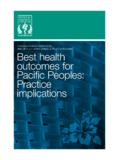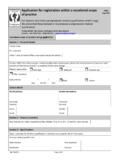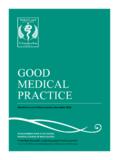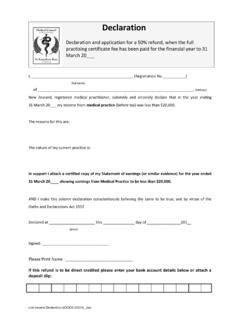Transcription of Best health outcomes for Maori: Practice implications
1 A resource booklet prepared for the Medical Council of New Zealand by M uri Ora AssociatesBest health outcomes for Maori: Practice implicationsAcknowledgementsBest health outcomes of M ori: Practice ImplicationsThis resource booklet has been prepared by M uri Ora Associates for the Medical Council of New Zealand. The Council would like to formally acknowledge the contribution of Prof Mason Durie, Dr Paratene Ngata, Dr James Te Whare all of whom reviewed the draft material, and the M uri Ora Associates team. To the many other people who have contributed to this booklet, thank check for updates to this document after December 2008. Best health outcomes for M ori: Practice implicationsContentsINTRODUCTION 03 BACKGROUND EVIDENCE 04M ori history and the Treaty of Waitangi 04 The Treaty of Waitangi and health 06M ori health 06 health inequalities 07 DIFFERENTIAL APPROACHES TO TREATMENT 08 CULTURAL COMPETENCE AND CLINICAL COMPETENCE 09 THE IMPACT OF CULTURE ON health 10 KEY M-AORI CONCEPTS 11 PRINCIPLES OF CULTURALLY COMPETENT CARE FOR M-AORI 14M ori community involvement 14 Ethnicity data collection and use 15 The central place of effective communications 16 Guidance on M ori preferences 17i.
2 M ori pronunciation and communication 17ii. Family/wh nau support 19iii. Initial contacts and protocols 19iv. Examining patients 20v. Physical contact 21vi. Body language 21vii. Sharing information and consent 22viii. Traditional medicine/Rongoa 22ix. Karakia and use of cultural experts 23x. Special issues 231. Surgery 232. Anaesthesia 243. Mental health 244. Pain 255. Hospitals 256. Mate M ori 25xi. Death and dying 26xii. Autopsies 28 CASE STUDIES 30 SUMMARY 39 GLOSSARY OF M-AORI wORDS 40 REFERENCES 42 Best health outcomes for M ori: Practice implicationsIntroductionThis resource booklet is designed to assist branch advisory bodies and doctors in meeting cultural competence requirements of the health Practitioners Competence Assurance Act 2003 (HPCAA), and to address the health inequalities affecting M ori.
3 The booklet will complement the Medical Council of New Zealand (the Council) s Statement on best practices when providing care to M ori patients and their wh nau, and Statement on cultural competence. The goal of this booklet is to help doctors to achieve greater awareness of the cultural diversity and the place of M ori in New Zealand, and to assist in incorporating cultural competence for M ori into continuing education activities, recertification and Practice activities such as medical audits. The material provides both general guidance on M ori cultural preferences and specific examples around key issues. It is hoped that M ori specific cultural competencies will be developed in a framework of self-awareness so that doctors will be able to recognise their own values and attitudes, as well as the impact of these on their practices . Since its signing in 1840, the Treaty of Waitangi has come to be considered a statement of the individual and collective rights of M ori, the Crown s responsibility to M ori, and a charter for New Zealand as a whole.
4 1 The Treaty guarantees M ori equal access to national resources, and can be seen to require the government to ensure that M ori have at least the same level of health as non-M ori (although this is demonstrably not the case).1 The Treaty thus represents New Zealand s long-standing, but as yet unrealised, goal to optimise M ori health , as well as the national commitment to the well-being of M ori people.*The description of M ori culture in this booklet is necessarily generalised, and M ori patients, like those of all other populations, will have their own individual preferences and beliefs. Just as not every male patient likes to chat about sports during his examination and not every female patient worries about her weight, not every M ori patient will expect to say a blessing (karakia) before a medical procedure. It is up to the provider to learn the preferences of each patient, M ori or non-M ori, and to strive to put them at ease, in order to create and sustain a respectful, trusting therapeutic relationship.
5 The best way for a doctor to learn about M ori is by establishing relations with the following groups in their locality: iwi, M ori health care professionals, marae komiti, and other M ori organisations in their local areas. This booklet provides background information to make you more comfortable in broaching issues with these groups and individual patients, but no document can take the place of direct person-to-person contact as the best way to learn another s culture. *See Ministry of health Implementing the New Zealand health Strategy (Ministry of health 2003), for further information on Acknowledging the Special Relationship between M ori and the Crown under the Treaty of Waitangi . Best health outcomes for M ori: Practice implicationsBackground evidence M ori history and the Treaty of WaitangiAccording to traditional stories, M ori arrived in Aotearoa New Zealand from Hawaiki, and were well established by the fourteenth century.
6 M ori adapted their east Polynesia cultural traditions to the land over at least 500 years before contact with European explorers. After Captain Cook s exploration of New Zealand in the late eighteenth century, an increasing number of settlers came to New Zealand. In 1833, the British Government appointed James Busby as British Resident to protect British trading interests and counter the increasing lawlessness amongst traders and settlers. Despite Busby s presence, problems, including the number of dubious land sales, increased but the foreign population still continued to grow. By 1839, there were an estimated 2,000 P keh and 150,000 M ori living in New Zealand. In 1840, the British Government sent Captain William Hobson there as Lieutenant-Governor, with the express mission to sign a treaty with the native M ori chiefs. Hobson arrived with instructions from Lord Normanby from the Colonial Office to acquire sovereignty over New Zealand.
7 His instructions included the recognition of New Zealand as a sovereign and independent state and went on in an almost apologetic way about the necessity of British intervention. The Crown could make no claim on New Zealand without M ori agreement because Britain had earlier recognised M ori rights in a document signed in 1835 by 52 M ori chiefs at the instigation of James Busby. This document, the Declaration of Independence , established the country as an independent state and stated that all sovereign power and authority would reside in the hereditary chiefs and tribal leaders who asked Britain s King William IV to protect their nation from all attempts upon its this time New Zealand was still firmly under tribal control. The cultural framework of New Zealand in 1840 was still essentially Polynesian, and all European residents absorbed M ori values to some extent.
8 Some Europeans were incorporated, however loosely, into a tribal structure, and the basic social divisions were tribal, not the European divisions of race, class or During this period, many M ori prospered: in 1857 the Bay of Plenty, Taupo and Rotorua M ori about 8,000 people had upwards of 3,000 acres of land in wheat, 300 acres in potatoes, nearly 2,000 acres in maize, and upwards of 1,000 acres of kumara. They owned nearly 100 horses, 200 head of cattle, 5,000 pigs, 4 water-power mills, and 96 ploughs, as well as 43 coastal vessels averaging nearly 20 tonnes There was also a strong desire by M ori to gain the literacy skills of the Europeans. M ori tribes encouraged missionaries to settle in their areas to acquire these skills. This not only gave them increased standing with other tribes, but opened up further trade with other treaty was drawn up and, after a single day of debate, signed on February 6, 1840, at Waitangi in the Bay of Islands.
9 Forty-three Northland chiefs signed the Treaty of Waitangi on that day, and over the next eight months, the Treaty was signed at more than 40 other locations. A total of 532 M ori chiefs signed, including some women, but Best health outcomes for M ori: Practice implicationsmany important chiefs refused to sign the Treaty, including Te Wherowhero of Waikato, Taraia of Thames, Tupaea of Tauranga, Te Arawa of Rotorua and Te Heu Heu of Treaty was translated into M ori by Henry Williams, an English missionary, prior to being debated at Waitangi. Both versions of the Treaty contain three Articles but the M ori translation differs significantly from the English version, resulting in two documents with words of different meaning and interpretation. The first Article covers sovereignty. The English version states that M ori give up their sovereignty to the British Crown, describing it as a complete transference of power to the Crown.
10 By contrast, the M ori version implies a sharing of power and uses the word kawanatanga , an improvised word which did not mean a transfer of authority from M ori to British hands, but implied the setting up of a government by the British. The nearest M ori equivalent to the English term would have been mana or rangatiratanga .The second Article, mainly about the protection of property rights, also concerns tino rangatiratanga or chieftainship. The M ori version promises much broader rights for M ori in regard to possession of their existing properties. The English version specifically gives M ori control over their lands, forests, fisheries and other properties, but the M ori version implies possession and protection of cultural and social items such as language and villages. Explanations given at the Treaty signings support the conclusion that though the M ori expected the Treaty to initiate a new relationship with the British, it would be one in which M ori and P keh would share authority.















